Table of Contents
- Introduction
- Editor’s Choice
- Energy Value and Nutrient Content of Common Foods
- Tolerable Intake Level for Nutrients by Nutrition Industry Statistics
- Functional and Natural Health Food Market Value by Nutrition Industry Statistics
- Dietary Supplements Market Value by Nutrition Industry Statistics
- Global Clinical Nutrition Industry Value Statistics
- Sports Nutrition Industry Value Statistics
- Sales and Consumption Trends
- Regional Analysis
- Demographic Insights
- Consumer Behavior and Trends
- Satisfaction of Consumers Concerning the Health Benefits of Food Supplements
- Spending Habits and Cost by Nutrition Industry Statistics
- Recent Trends
- Regulations for Nutrition Industry Products Statistics
- Recent Developments
- Conclusion
- FAQs
Introduction
Nutrition Industry Statistics: The nutrition industry is a diverse field encompassing dietary supplements, functional foods, clinical nutrition, sports nutrition, and organic products.
It is shaped by trends such as a focus on health and wellness. Digital health integration, sustainability, and personalized nutrition. Major players include large food and beverage companies as well as specialized nutritional firms.
Moreover, challenges include regulatory compliance and market saturation, while opportunities arise from innovation, emerging markets, and technology integration. The industry is driven by consumer demand for healthier lifestyles and environmental sustainability.
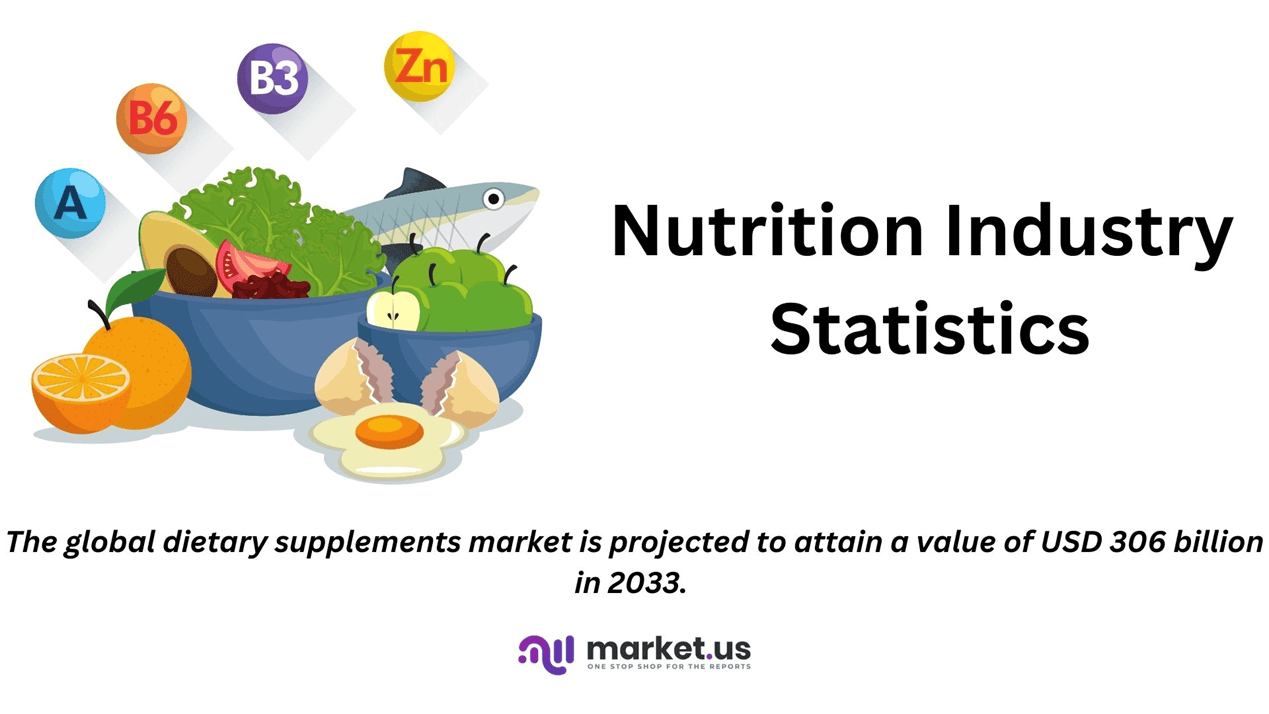
Editor’s Choice
- Healthy Snack Market size was valued at USD 84.4 billion and is expected to grow to around USD 142.6 billion by 2032
- The global functional and natural health food market revenue is expected to reach USD 24.75 billion in 2024.
- The global dietary supplements market is projected to attain a value of USD 306 billion in 2033.
- Sports non-protein products increased from USD 1.8 billion in 2014 to USD 2.1 billion in 2016. Reaching USD 2.4 billion in 2018 and further rising to USD 2.6 billion by 2020.
- In 2023, global animal protein consumption is estimated to vary significantly by source. Fish leads the consumption chart with an estimated 165 million metric tons.
- In 2019, Canadian respondents showed a strong interest in healthy food trends and a strong inclination towards plant-based and innovative food options. Plant-based meat substitutes garnered the highest interest, with 75% of respondents expressing interest.
- In 2017, the most popular types of vitamin and mineral supplements among U.S. adults were led by multivitamins. With 73% of adult supplement users incorporating them into their routine.
- In 2019, French consumers had varied opinions on the health benefits of nutritional supplements. A significant majority, 61%, reported being rather satisfied. With the health benefits provided by these products.
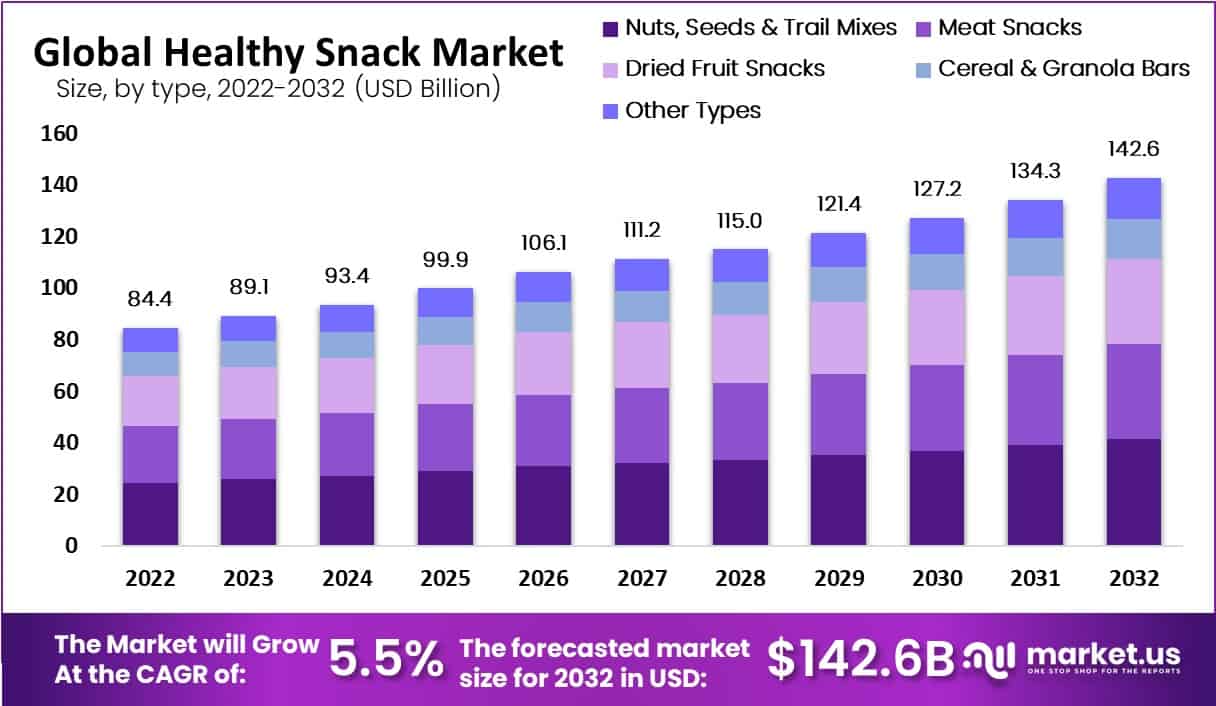
Energy Value and Nutrient Content of Common Foods
- The energy value and nutrient content of common foods vary significantly across different food items.
- A slice of whole wheat bread (28 g) provides 69 kcal, with 12.9 g of carbohydrates, 2.7 g of protein, 1.2 g of fat, and 10.6 g of water. In comparison, a slice of white bread (25 g) contains 67 kcal, 12.4 g of carbohydrates, 2.0 g of protein, 0.9 g of fat, and 9.2 g of water.
- One cup of cooked, enriched, short-grain white rice (186 g) delivers 242 kcal, 53.4 g of carbohydrates, 4.4 g of protein, 0.4 g of fat, and 127.5 g of water.
- An eight-fl oz serving of 2% low-fat milk (244 g) offers 121 kcal, 11.7 g of carbohydrates, 8.1 g of protein, 4.7 g of fat, and 17.7 g of water. A teaspoon of butter (5 g) provides 36 kcal, with no carbohydrates or protein, 4.1 g of fat, and 0.8 g of water.
- Cheddar cheese (1 oz, 28 g) has 114 kcal, 0.4 g of carbohydrates, 7.1 g of protein, 9.4 g of fat, and 10.4 g of water. Broiled lean ground beef (3.5 oz, 100 g) contains 272 kcal, no carbohydrates, 24.7 g of protein, 18.5 g of fat, and 55.7 g of water.
Moreover
- Tuna canned in oil drained (3 oz, 85 g) provides 168 kcal, no carbohydrates, 24.8 g of protein, 7.0 g of fat, and 50.9 g of water. A boiled potato without skin (1 medium, 135 g) offers 117 kcal, 27.2 g of carbohydrates, 2.5 g of protein, 0.1 g of fat, and 103.9 g of water.
- Half a cup of boiled frozen green peas (80 g) delivers 62 kcal, 11.4 g of carbohydrates, 4.1 g of protein, 0.2 g of fat, and 63.6 g of water. Raw red cabbage (1/2 cup shredded, 35 g) contains 9 kcal, 2.1 g of carbohydrates, 0.5 g of protein, 0.1 g of fat, and 32.0 g of water.
- A navel orange (1 fruit, 131 g) offers 60 kcal, 15.2 g of carbohydrates, 1.3 g of protein, 0.1 g of fat, and 113.7 g of water. An apple with skin (1 medium, 138 g) provides 81 kcal, 21.0 g of carbohydrates, 0.3 g of protein, 0.5 g of fat, and 115.8 g of water.
- Lastly, one teaspoon of granulated white sugar (4 g) contains 15 kcal 4.0 g of carbohydrates, with no protein or fat content.
(Source: Britannica)
Tolerable Intake Level for Nutrients by Nutrition Industry Statistics
- The tolerable upper intake levels (UL) for selected nutrients for adults guide the maximum daily intake to avoid adverse health effects. For calcium, the UL is set at 2,500 milligrams per day. Copper and fluoride each have a UL of 10 milligrams per day.
- The UL for synthetic forms of folic acid from supplements or fortified foods is 1,000 micrograms per day, while iodine’s UL is 1,100 micrograms. The UL for iron is 45 milligrams per day.
- Magnesium’s UL, which applies only to intake from pharmacological agents and excludes food and supplements, is 350 milligrams per day. Manganese has a UL of 11 milligrams per day, and niacin’s UL, for synthetic forms, is 35 milligrams per day.
- The UL for phosphorus is 4 grams per day, while selenium’s UL is 400 micrograms. For preformed vitamin A (excluding beta-carotene), the UL is 3,000 micrograms (10,000 IU) per day. The UL for vitamin B6 is 100 milligrams per day, and for vitamin C, it is 2,000 milligrams per day.
- Vitamin D has a UL of 50 micrograms (2,000 IU) per day. While the UL for synthetic vitamin E from supplements or fortified foods is 1,000 milligrams per day. Lastly, the UL for zinc is 40 milligrams per day.
(Source: Britannica)
Functional and Natural Health Food Market Value by Nutrition Industry Statistics
- The global functional and natural health food market has been experiencing consistent growth. With its value reaching USD 23.50 billion in 2023.
- Projections indicate a steady increase over the following years. The market is expected to grow to USD 24.75 billion in 2024 and USD 26.06 billion in 2025.
- This upward trend continues, with market values anticipated to reach USD 27.44 billion in 2026, USD 28.89 billion in 2027, and USD 30.42 billion in 2028.
- By 2029, the market is projected to be valued at USD 32.04 billion. Further increasing to USD 33.73 billion in 2030.
- The growth trajectory is expected to persist, with the market reaching USD 35.52 billion in 2031, USD 37.40 billion in 2032, and culminating at USD 38.50 billion by 2033.
- This consistent growth underscores the increasing consumer demand for functional and natural health food products.
(Source: Statista)
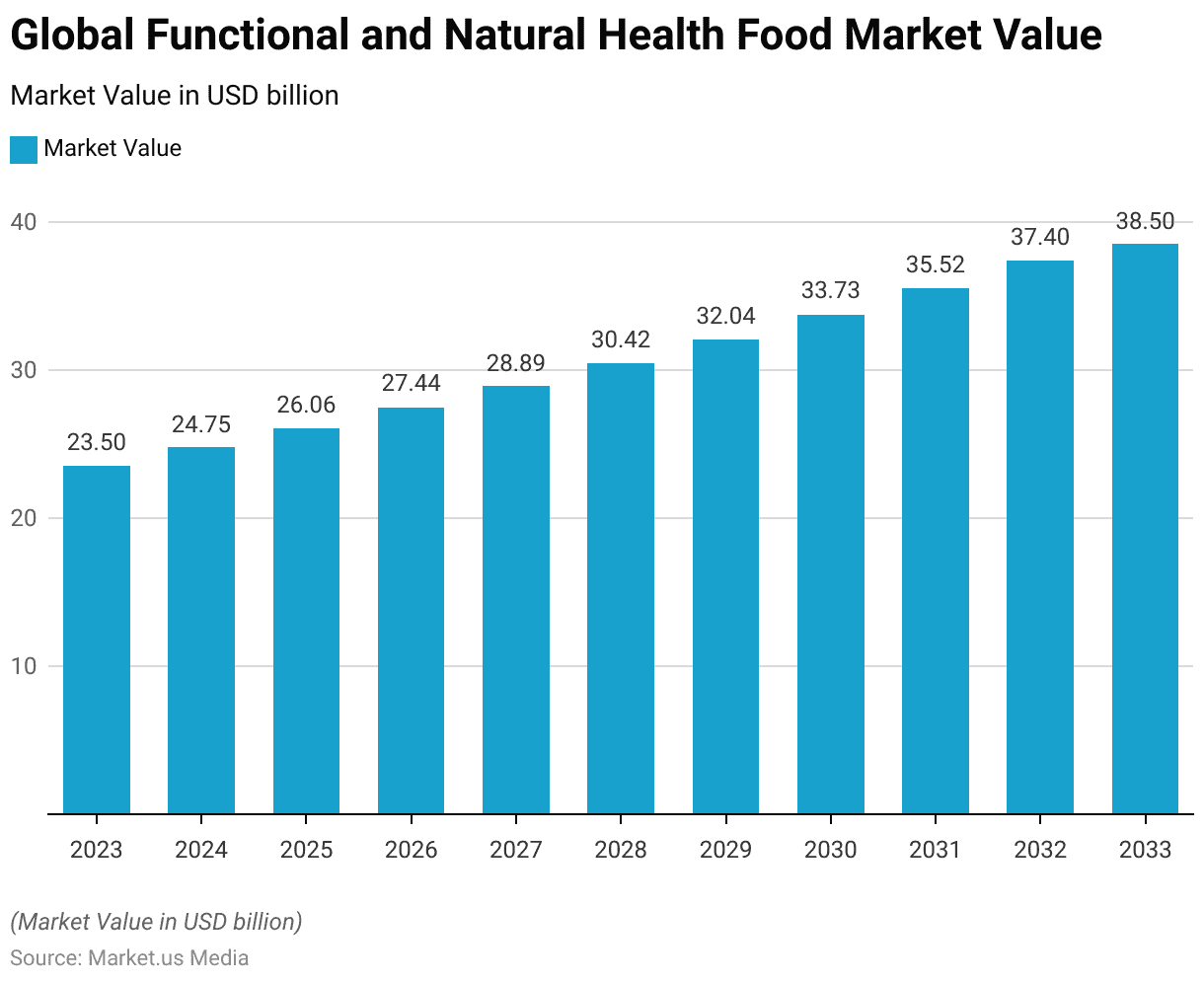
Dietary Supplements Market Value by Nutrition Industry Statistics
- The global dietary supplements market is projected to witness substantial growth over the coming decade at a CAGR of 7.0%.
- In 2023, the market value is estimated at USD 156 billion.
- This upward trajectory is expected to continue. With market values forecasted to reach USD 167 billion in 2024 and USD 178 billion in 2025.
- By 2026, the market is anticipated to grow to USD 191 billion, further increasing to USD 204 billion in 2027.
- The growth momentum is expected to persist. The market is projected to reach USD 218 billion in 2028 and USD 234 billion in 2029.
- By 2030, the market value is anticipated to rise to USD 250 billion. Continuing its growth to USD 268 billion in 2031 and USD 286 billion in 2032.
- By 2033, the global dietary supplements market is expected to attain a value of USD 306 billion.
- This consistent increase reflects the rising consumer demand for dietary supplements worldwide.
(Source: market.us)
Take advantage of our unbeatable offer - buy now!

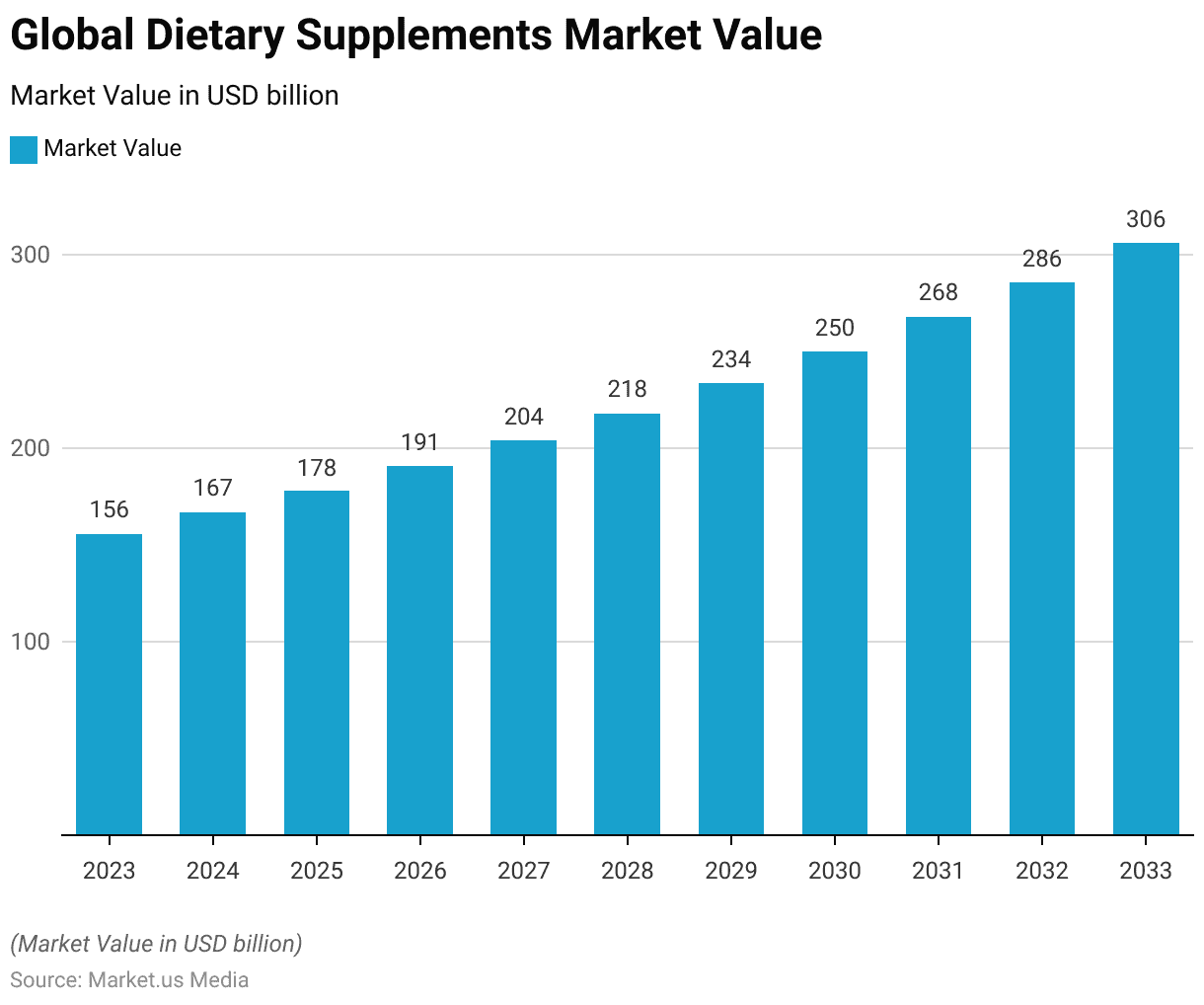
Global Clinical Nutrition Industry Value Statistics
- The global clinical nutrition market has been exhibiting significant growth at a CAGR of 6.2%. With a market value of USD 47.4 billion in 2022.
- This upward trend is projected to continue, reaching USD 50.3 billion in 2023 and USD 53.1 billion in 2024.
- By 2025, the market is expected to grow to USD 57.2 billion, further increasing to USD 61.2 billion in 2026.
- The positive growth trajectory continues. With market values anticipated to reach USD 64.5 billion in 2027 and USD 67.0 billion in 2028.
- By 2029, the market is projected to be valued at USD 71.1 billion. Further rising to USD 75.0 billion in 2030.
- The growth is expected to persist, with the market reaching USD 79.6 billion in 2031 and USD 85.2 billion by 2032.
- This consistent growth underscores the increasing demand for clinical nutrition products globally.
(Source: market.us)
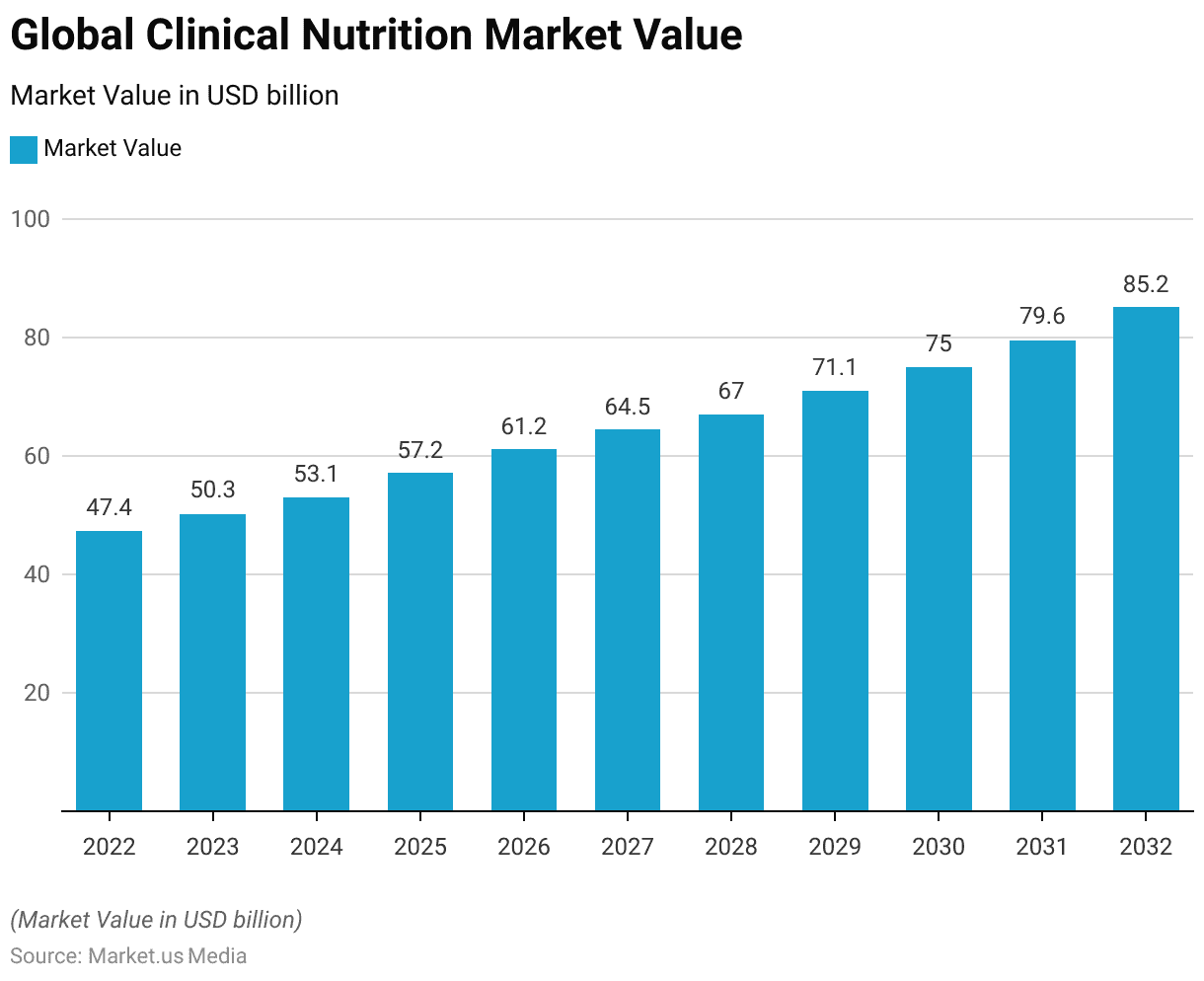
Sports Nutrition Industry Value Statistics
- The global sports nutrition market is experiencing robust growth at a CAGR of 7.6 %, with its value recorded at USD 42.1 billion in 2022.
- This growth is projected to continue, with the market expected to reach USD 45.3 billion in 2023 and USD 48.3 billion in 2024.
- By 2025, the market is anticipated to grow to USD 52.9 billion, further increasing to USD 57.5 billion in 2026.
- The positive trend is expected to persist, with market values projected to reach USD 61.3 billion in 2027 and USD 64.2 billion in 2028.
- By 2029, the market value is expected to rise to USD 69.0 billion, continuing its growth to USD 73.6 billion in 2030.
- The growth trajectory is set to maintain momentum. The market is anticipated to reach USD 79.2 billion in 2031 and USD 86.0 billion by 2032.
- This consistent increase reflects the growing consumer demand for sports nutrition products globally.
(Source: market.us)

Sales and Consumption Trends
Global Consumer Sports Nutrition Industry Sales Statistics
- Global consumer sports nutrition sales have shown significant growth across various product types from 2014 to 2020.
- Sports non-protein products increased from USD 1.8 billion in 2014 to USD 2.1 billion in 2016, reaching USD 2.4 billion in 2018 and further rising to USD 2.6 billion by 2020.
- Sales of sports protein ready-to-drink (RTD) products grew from USD 1 billion in 2014 to USD 1.1 billion in 2016, then to USD 1.4 billion in 2018, and USD 1.5 billion in 2020.
- The market for sports protein powder saw substantial growth, escalating from USD 6.2 billion in 2014 to USD 7.7 billion in 2016, reaching USD 9.3 billion in 2018 and USD 10.9 billion by 2020.
- Similarly, sales of sports protein bars increased from USD 0.8 billion in 2014 to USD 1 billion in 2016, then to USD 1.1 billion in 2018, and USD 1.2 billion by 2020.
- This data underscores the rising consumer demand and expanding market for various sports nutrition products globally.
(Source: Statista)

Vitamins and Minerals Sales Growth
- The annual change in sales value of over-the-counter (OTC) vitamins and minerals in Great Britain from 2010 to 2023 exhibited fluctuating trends.
- In 2010, there was a decrease of 1.2% in sales. Which was followed by a modest increase of 1.2% in 2011.
- The year 2012 saw a significant rise of 5%, while 2013 experienced a smaller increase of 1.8%.
- In 2014, sales dipped by 1.1%.
- After a gap in data for 2015, 2016 witnessed a 2.45% increase, and 2017 saw a slight rise of 0.5%.
- The upward trend continued in 2018, with a 3.3% increase and a 2.2% rise in 2019.
- The most notable growth occurred in 2020, with a substantial increase of 14.3%.
- However, this was followed by a 3% decline in 2021.
- Sales rebounded slightly in 2022 with a 1.6% increase, and the trend continued positively in 2023 with a 6% rise.
- This data reflects the variable yet overall positive trajectory in the sales of OTC vitamins and minerals over the years.
(Source: Statista)
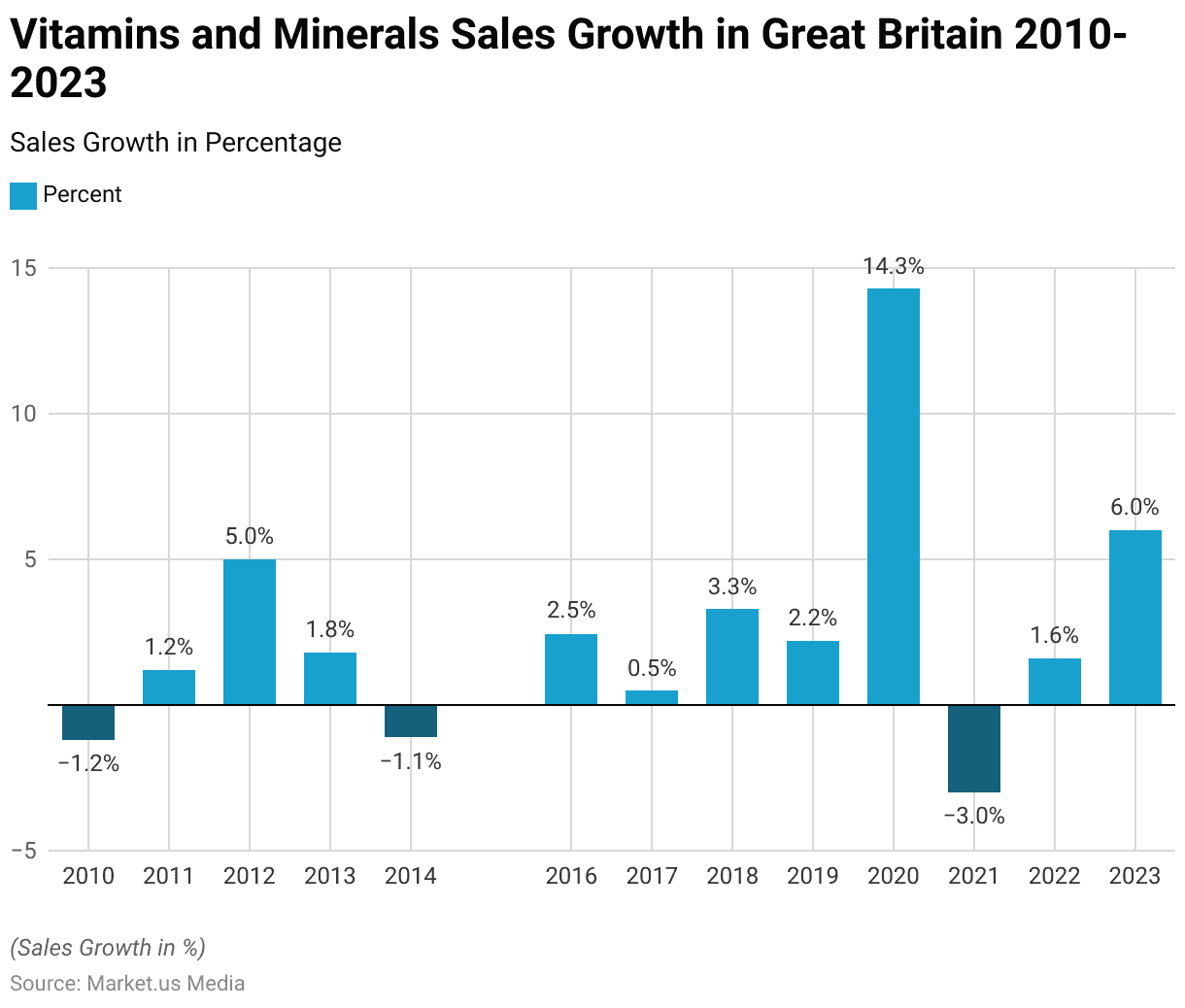
Global Animal Protein Consumption
- In 2023, global animal protein consumption is estimated to vary significantly by source. Fish leads the consumption chart with an estimated 165 million metric tons.
- Poultry follows with a substantial consumption of 140 million metric tons.
- Pork is also a major source of animal protein, with an estimated consumption of 122 million metric tons.
- Beef consumption is projected at 72 million metric tons, indicating its significant role in global diets.
- Atlantic salmon, while lower in comparison, still contributes to the animal protein market with an estimated consumption of 2 million metric tons.
- These figures reflect the diverse preferences and significant demand for various sources of animal protein worldwide.
(Source: Statista)
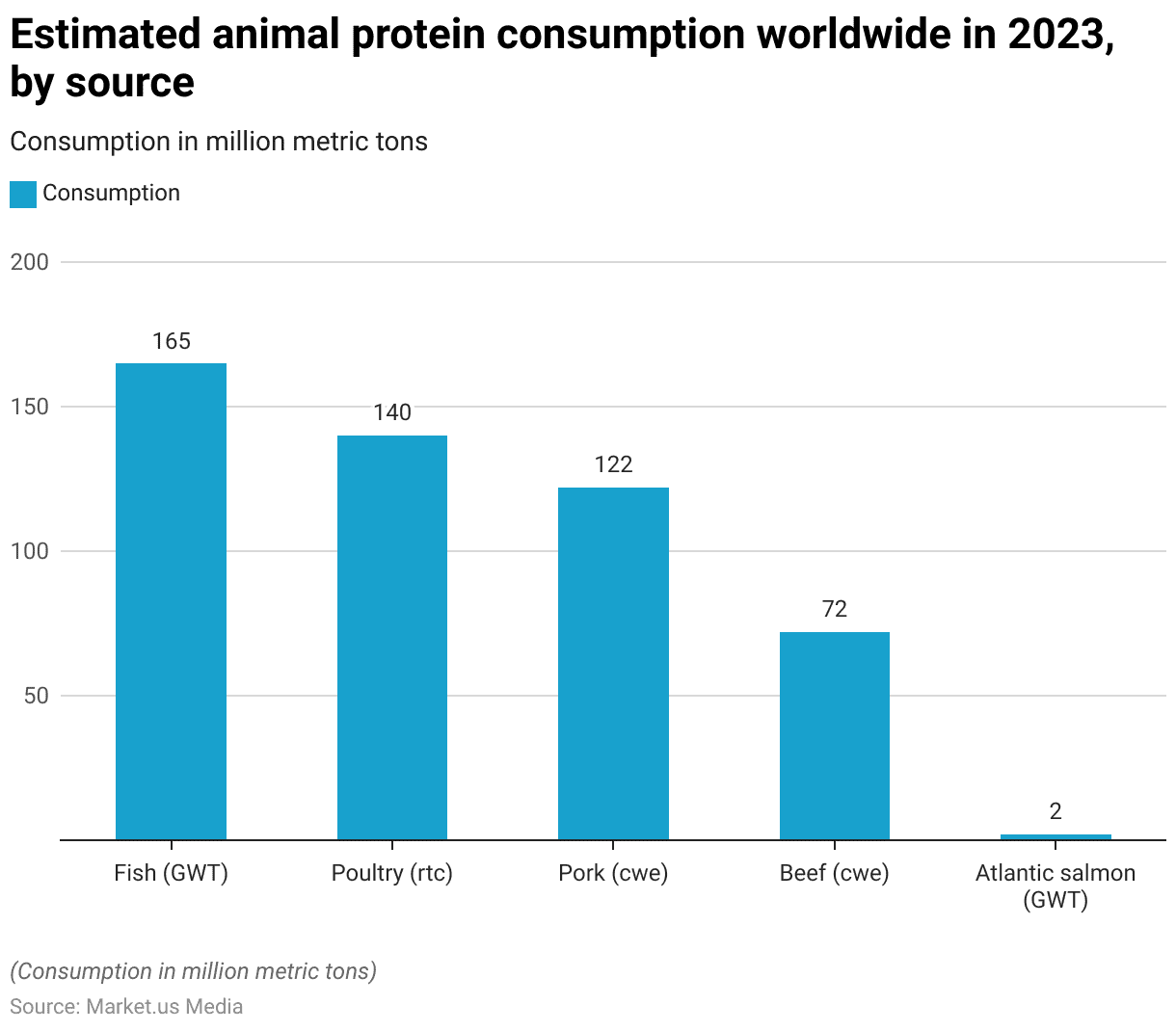
Regional Analysis
Europe
Value of the Dietary Supplements Market in Europe – By Country
Major Countries
- The dietary supplements market in Europe demonstrated notable growth across various countries between 2015 and 2020. In Italy, the market value increased from 1,424.2 million euros in 2015 to 1,601.5 million euros in 2020.
- Russia saw a significant rise from 887.7 million euros to 1,079.9 million euros over the same period. Germany’s market remained relatively stable, with a slight increase from 966.6 million euros to 967.2 million euros.
- The United Kingdom experienced growth from 737 million euros to 755.2 million euros, while France saw an increase from 683.8 million euros to 724.8 million euros. In Poland, the market value rose from 353.4 million euros to 407.5 million euros, and Norway saw a slight decrease from 231.5 million euros to 220.4 million euros.
- Finland’s market value increased from 201.2 million euros to 207.4 million euros, and Sweden experienced growth from 181.5 million euros to 199.3 million euros. Belgium’s market remained stable, increasing marginally from 193.6 million euros to 194 million euros, while Spain saw growth from 182.6 million euros to 193.5 million euros.
- The Netherlands’ market value increased from 142.1 million euros to 169.2 million euros, and Hungary saw an increase from 116.6 million euros to 136.3 million euros. Turkey’s market grew from 96 million euros to 121.7 million euros, and Romania saw substantial growth from 72.2 million euros to 101.8 million euros.
Other Countries
- Denmark’s market remained relatively stable, increasing from 96.5 million euros to 98.7 million euros, while the Czech Republic experienced growth from 84.7 million euros to 96.1 million euros.
- Switzerland’s market saw a slight decrease from 93 million euros to 92.7 million euros, whereas Austria’s market value increased from 81.7 million euros to 91.9 million euros.
- Ukraine experienced growth from 75.7 million euros to 87.1 million euros, Lithuania from 45.4 million euros to 50.6 million euros, and Greece saw a significant increase from 30.1 million euros to 43.4 million euros. Ireland’s market grew from 35.9 million euros to 38.2 million euros, and Slovenia experienced growth from 33.8 million euros to 36.6 million euros.
- Bulgaria’s market value increased from 22.5 million euros to 25.5 million euros, while Portugal’s market remained stable, increasing slightly from 24.3 million euros to 24.5 million euros.
- Serbia’s market value grew from 19 million euros to 21.1 million euros, and Belarus saw an increase from 15.5 million euros to 17.2 million euros.
- Latvia’s market increased from 11.4 million euros to 13.6 million euros, Croatia’s market grew marginally from 11.3 million euros to 11.7 million euros, and Bosnia and Herzegovina experienced growth from 9.2 million euros to 11.3 million euros.
- Estonia’s market value increased slightly from 6.7 million euros to 7.1 million euros, Georgia saw growth from 6.1 million euros to 6.8 million euros, and Macedonia’s market value increased from 3.7 million euros to 4.4 million euros.
- This data highlights the overall expansion and growing demand for dietary supplements across Europe during this period.
(Source: Statista)

North America
Canada
Number of Food Health Supplement Stores in Canada
- As of December 2022, Canada had a total of 1,591 food health supplement stores distributed across various regions.
- Ontario led with the highest number, totaling 611 stores.
- British Columbia followed with 397 stores, while Quebec had 214 stores.
- Alberta accounted for 203 stores, and Manitoba had 52 stores.
- Saskatchewan hosted 39 stores, New Brunswick had 28, and Nova Scotia featured 26 stores.
- Newfoundland and Labrador had 12 stores, Prince Edward Island had 5, and Yukon had the fewest, with four stores.
- This distribution indicates a significant concentration of food health supplement stores in the more populated regions of Ontario and British Columbia.
(Source: Statista)
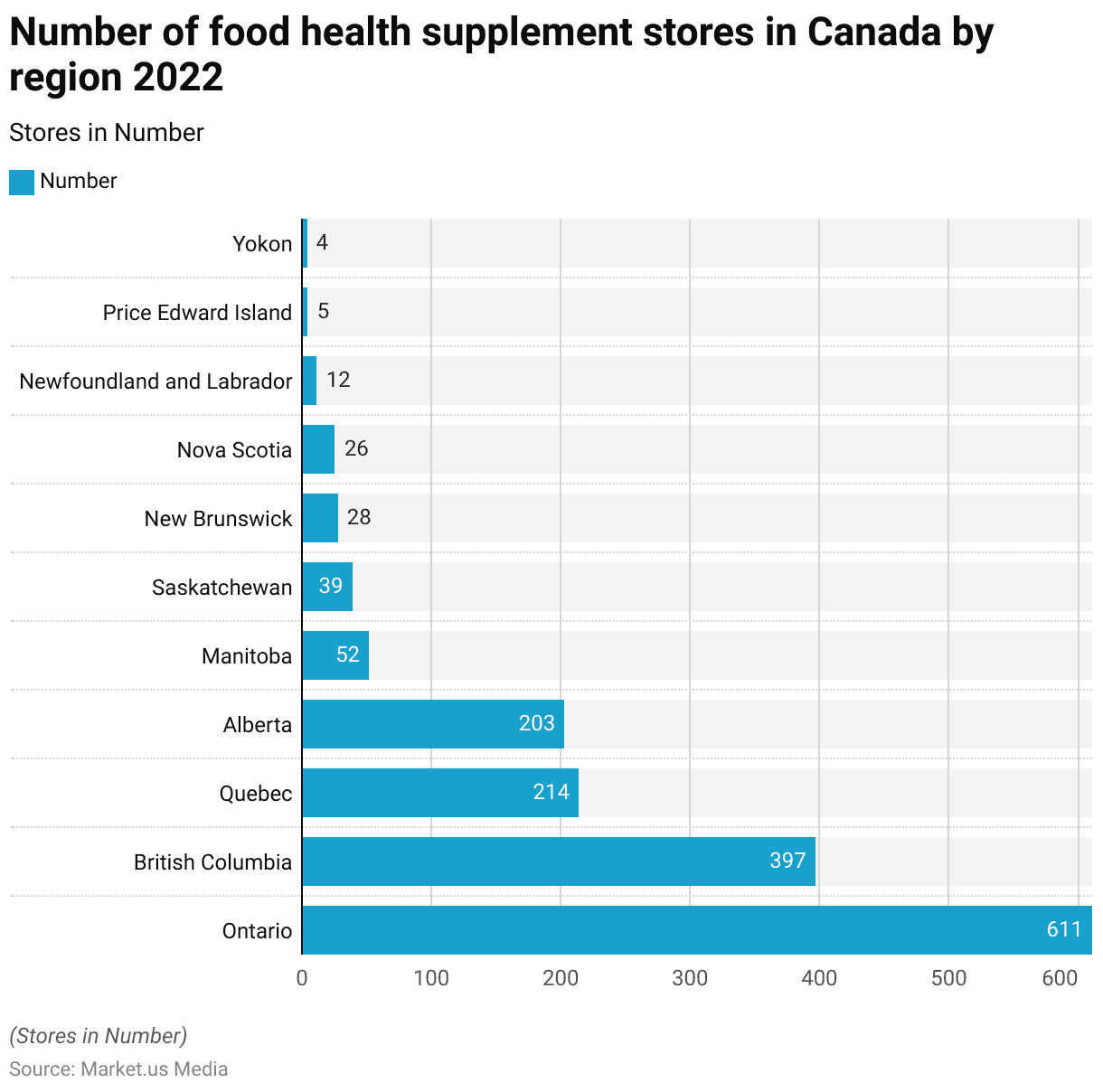
United States
Dietary Supplement Usage in U.S. Adults – By Region
- In 2019, the usage of dietary supplements among U.S. adults varied by region. In the Northeast, 73% of adults reported using dietary supplements.
- The South had the highest usage rate, with 80% of adults taking supplements.
- In the Midwest, the percentage was slightly lower at 74%, while the West reported a 78% usage rate.
- These figures highlight regional differences in the adoption of dietary supplements. The South leading in supplement usage among U.S. adults.
(Source: Statista)
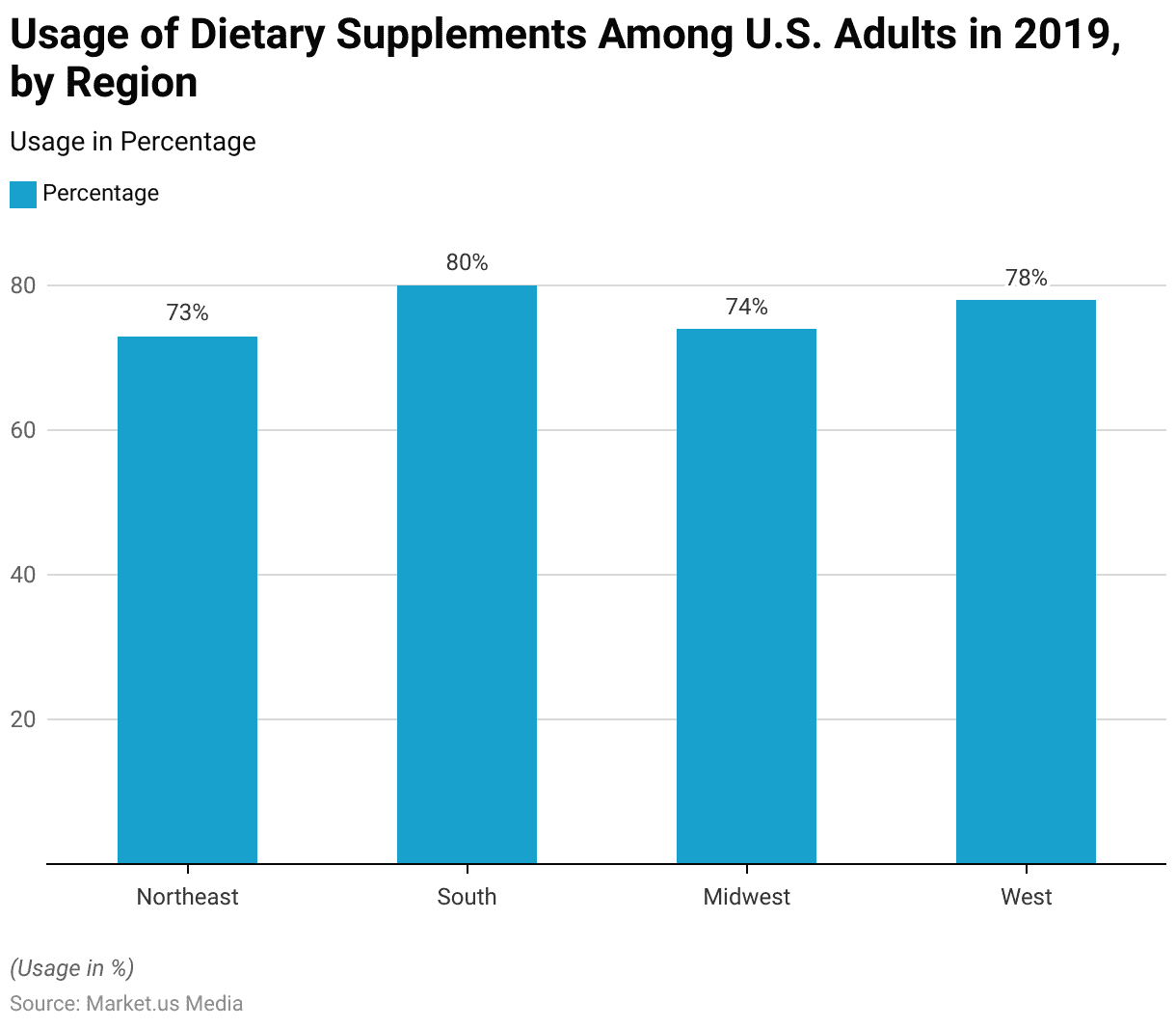
Asia-Pacific
India
Value of Ayurvedic and Herbal Products Exported from India
- The export value of Ayurvedic and herbal products from India has demonstrated a notable upward trend from the financial year 2015 to 2024.
- In FY 2015, the export value was USD 354.68 million, which increased to USD 364 million in FY 2016.
- This growth continued in FY 2017, with exports reaching USD 401.68 million.
- The financial year 2018 saw a significant rise to USD 456.12 million.
- However, there was a slight decline in FY 2019, with the value dropping to USD 446.13 million and further to USD 428.08 million in FY 2020.
- Despite these fluctuations, the export value surged to USD 539.87 million in FY 2021 and further climbed to USD 612 million in FY 2022.
- This positive trend continued, with the export value reaching USD 625.48 million in FY 2023 and an estimated USD 651.17 million in FY 2024.
- This data highlights the increasing global demand for Ayurvedic and herbal products from India over the years.
(Source: Statista)
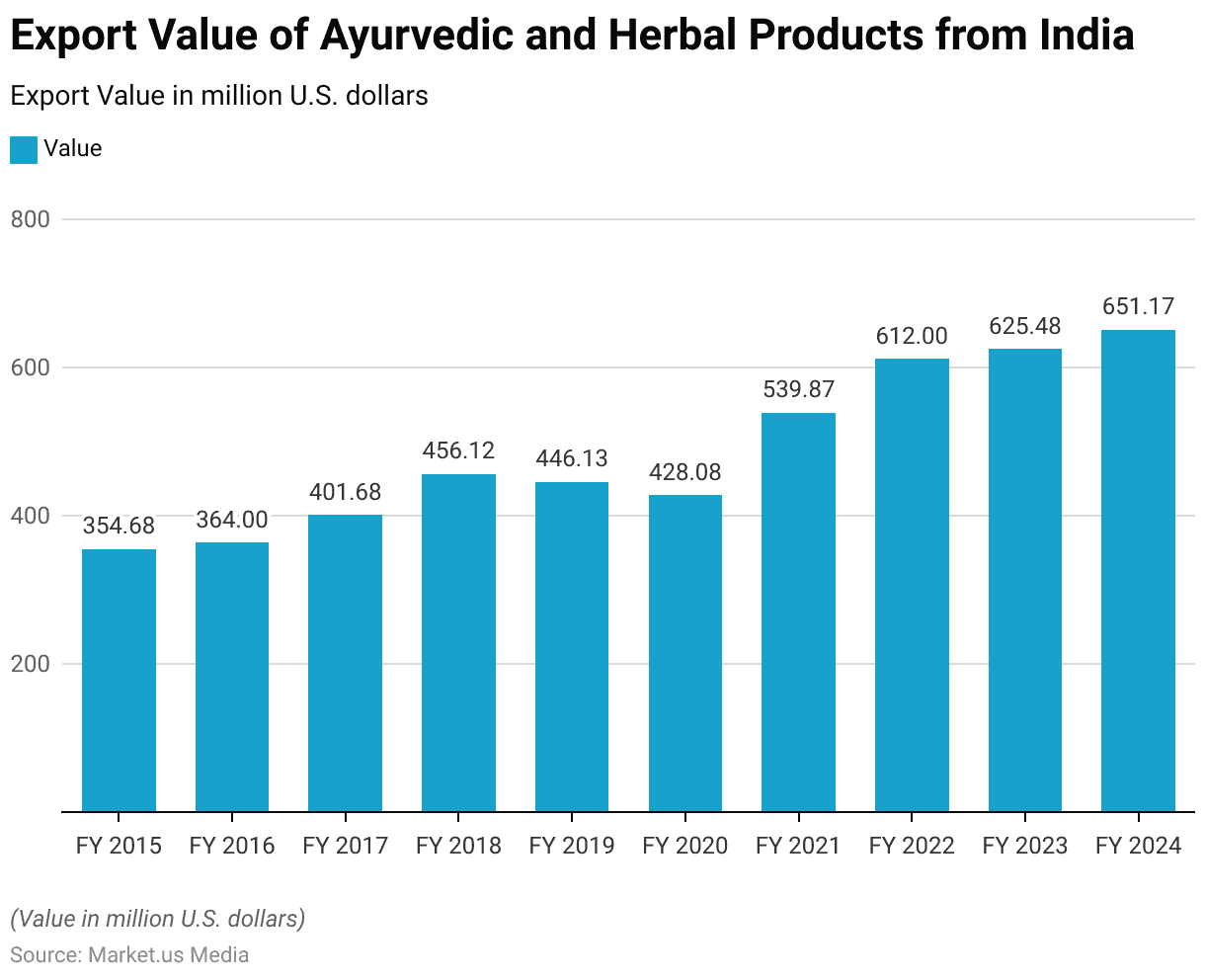
Japan
Dietary Supplements Market Distribution in Japan – By Type
- In fiscal year 2019, the distribution of the dietary supplements market in Japan was categorized by various types, reflecting diverse consumer preferences.
- Nutritional supplements accounted for 22% of the market, while products aimed at enhancing vitality constituted 21.4%.
- Supplements for joint and muscle strength made up 12.9% of the market, and beauty supplements represented 8.5%. Sports supplements comprised 7.2% of the market.
- The remaining 29.1% was attributed to other types of dietary supplements.
- This distribution illustrates the varied demand for dietary supplements across different health and wellness needs in Japan.
(Source: Statista)

China
Market Scale of Health Supplements Products in China
- The market scale of health supplements products in China has shown substantial growth from 2016 to 2023.
- In 2016, the market was valued at 144.6 million RMB.
- This figure increased to 161.4 million RMB in 2017 and further to 188 million RMB in 2018.
- The upward trend continued in 2019, with the market reaching 222.7 million RMB.
- By 2020, the market scale had grown to 250 million RMB, and it further expanded to 270.8 million RMB in 2021.
- In 2022, the market size increased to 298.9 million RMB, and it is projected to reach 328.3 million RMB in 2023.
- This consistent growth underscores the rising consumer demand for health supplements in China over the years.
(Source: Beauty Matter)

Demographic Insights
Age By Nutrition Industry Statistics
- In 2015, the consumption of vitamin and mineral supplements among adults in Scotland varied across different age groups.
- The share of respondents aged 16-24 who reported using these supplements was 21%.
- This percentage increased to 29% among those aged 25-34.
- For the 35-44 age group, 25% of respondents consumed vitamin and mineral supplements, while 24% of those aged 45-54 did so.
- Among individuals aged 55-64, the share was 26%.
- The highest consumption rates were observed in the older age groups, with 33% of those aged 65-74 and 34% of respondents aged 75 and above reporting supplement use.
- This data highlights a trend of increasing supplement consumption among adults of different ages in Scotland.
(Source: Statista)
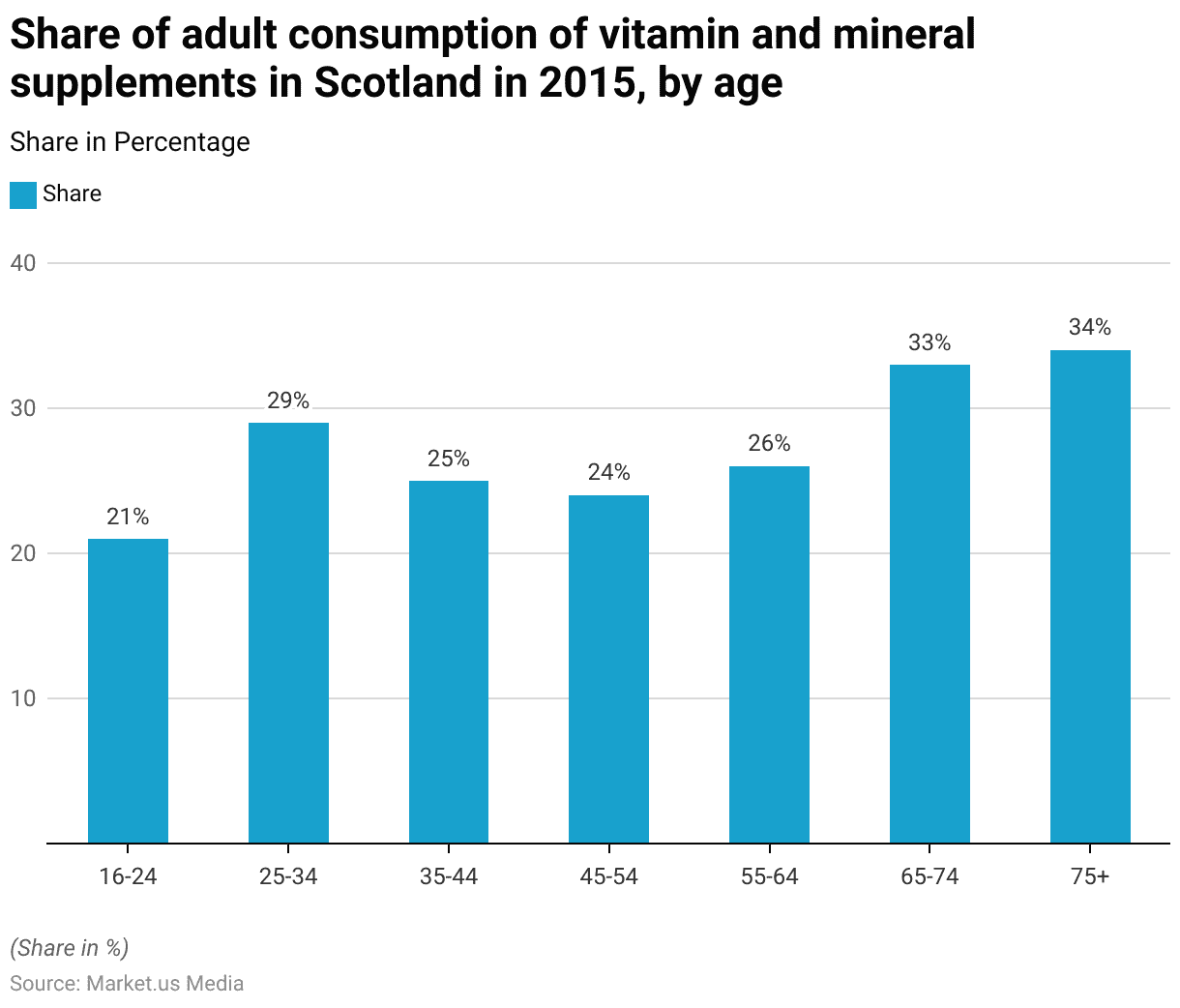
Gender By Nutrition Industry Statistics
- As of 2018, the usage of different types of dietary supplements among U.S. adults showed distinct patterns based on gender.
- Multivitamins were the most commonly used supplement, with 72% of women and 78% of men reporting their use.
- Vitamin D was taken by 40% of women and 35% of men.
- Calcium supplements were used by 32% of women, while no corresponding data was provided for men.
- Vitamin C consumption was higher among men (33%) compared to women (28%).
- Similarly, 28% of women and 24% of men reported using Vitamin B or B Complex supplements.
- Magnesium was taken by 22% of women, with no data for men. Protein supplements were used by 21% of both women and men.
- Probiotics were used by 21% of women, while 21% of men reported taking Omega-3 or fatty acid supplements, with no corresponding data for women.
- This data indicates gender-specific preferences in dietary supplement usage among U.S. adults.
(Source: Statista)
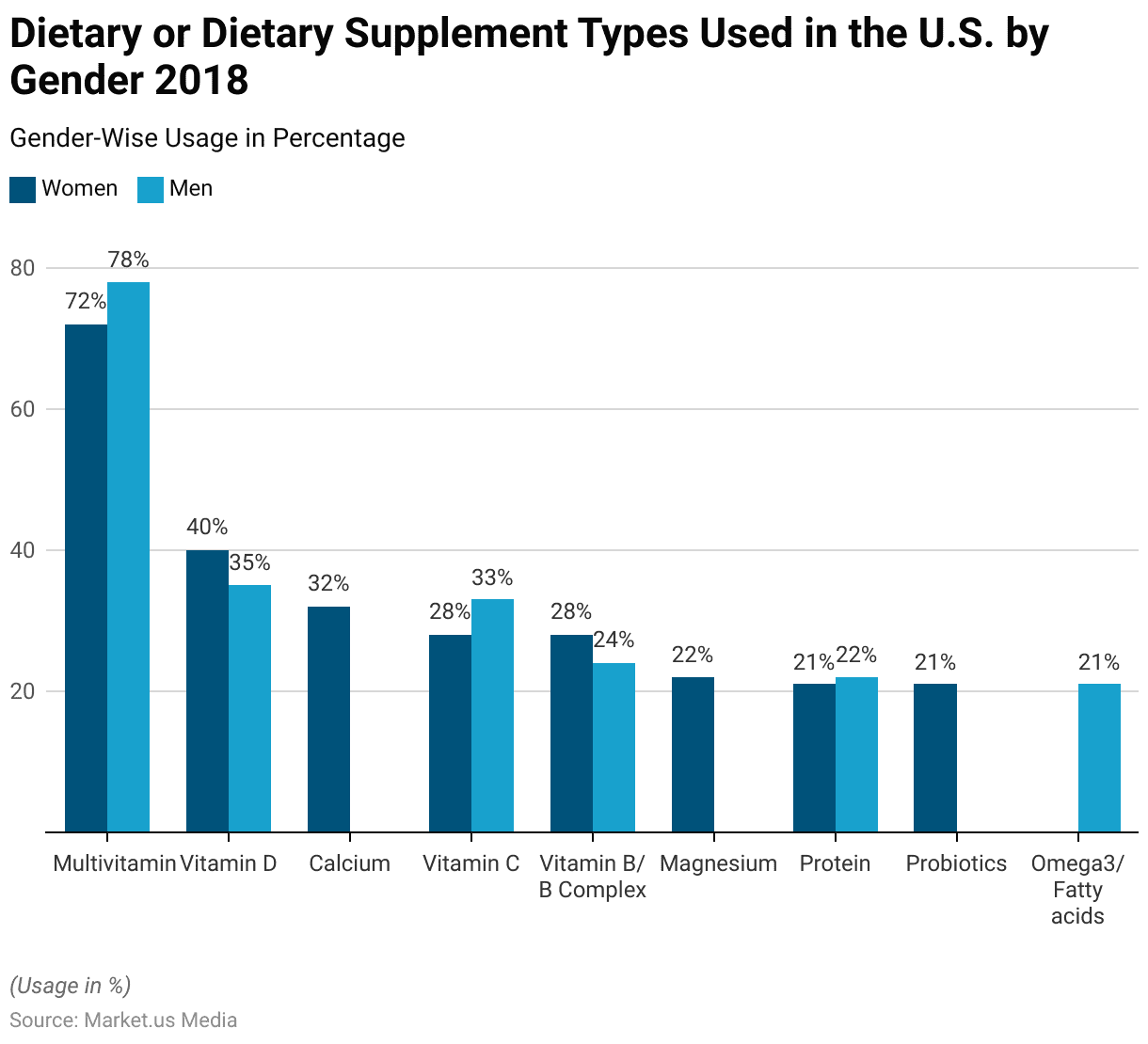
Ethnicity By Nutrition Industry Statistics
- From 2017 to 2018, the usage of dietary supplements among U.S. children and adolescents varied according to ethnicity.
- Among White, non-Hispanic individuals, 39.90% had used any dietary supplement in the past 30 days, with 8.60% using two or more supplements.
- For Black, non-Hispanic individuals, 20.80% reported using any dietary supplement, while 1.80% used two or more.
- Asian, non-Hispanic individuals had the highest reported usage, with 41.10% using any dietary supplement and 9.30% using two or more.
- Hispanic individuals reported a usage rate of 26.90% for any dietary supplement, with 6% using two or more.
- This data highlights the ethnic disparities in dietary supplement usage among U.S. children and adolescents during this period.
(Source: Statista)
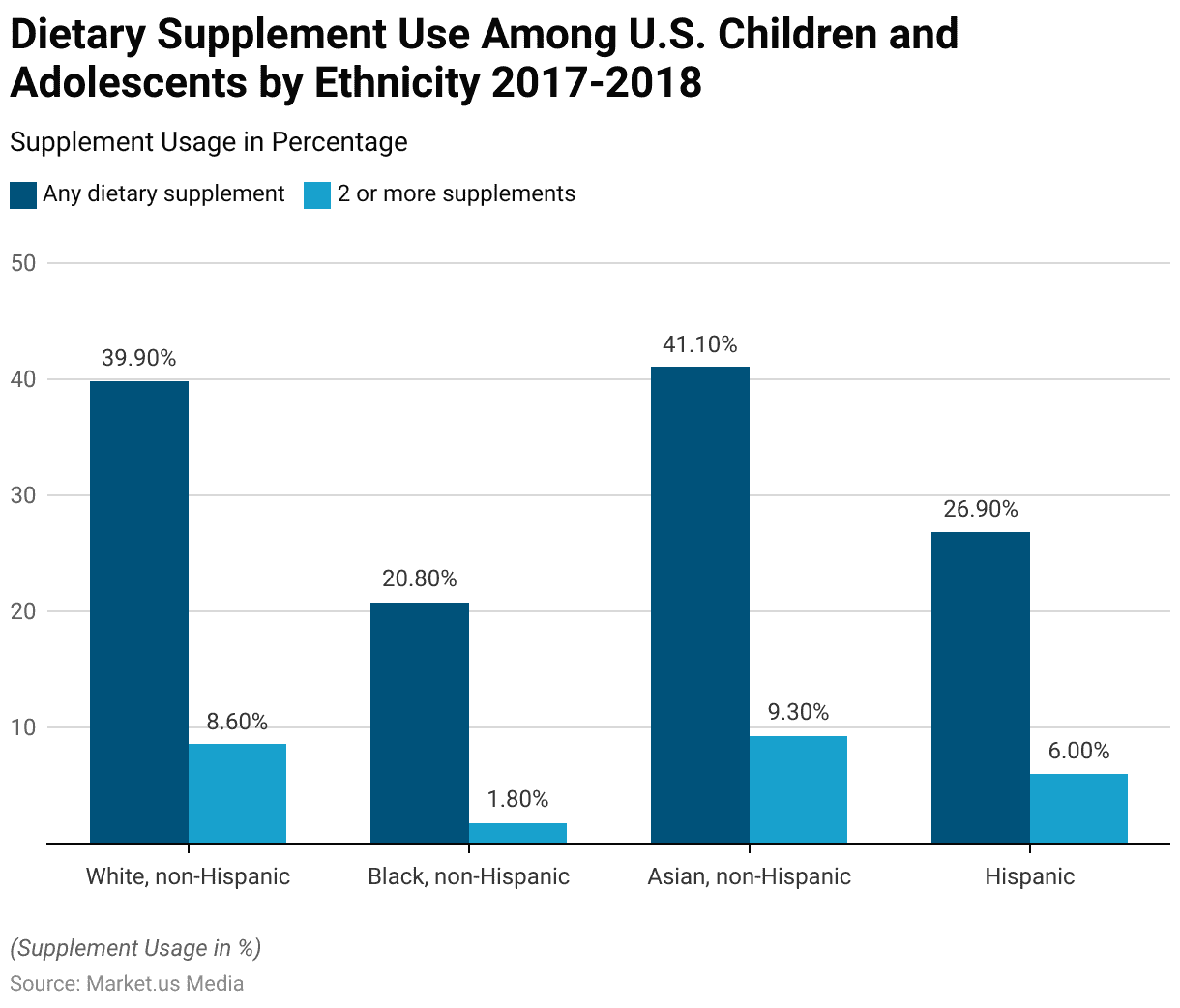
Income Group By Nutrition Industry Statistics
- In 2020, the usage of dietary supplements among U.S. adults varied by household income.
- Among adults with a household income under $50,000, 68% reported using dietary supplements.
- This percentage increased to 74% for those with a household income between $50,000 and $100,000.
- The highest usage rate was observed among adults with a household income over $100,000, with 77% reporting the use of dietary supplements.
- This data indicates a positive correlation between household income and the likelihood of dietary supplement usage among U.S. adults.
(Source: Statista)
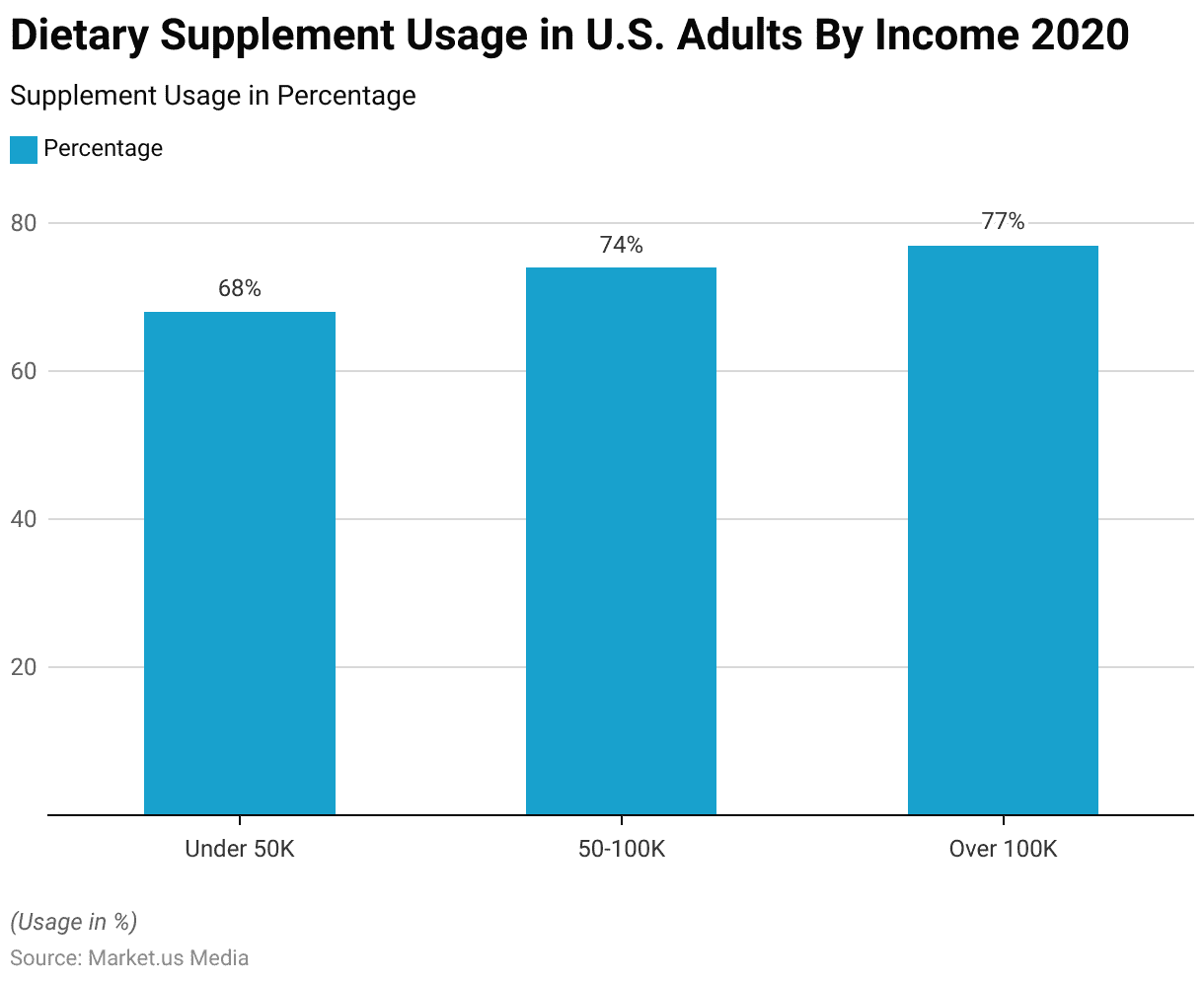
Education Level By Nutrition Industry Statistics
- In 2020, the usage of dietary supplements among U.S. adults varied by education level.
- Among those with a college degree, 75% reported using dietary supplements.
- In comparison, 70% of adults without a college degree reported using dietary supplements.
- This data suggests a slightly higher prevalence of dietary supplement usage among individuals with higher educational attainment.
(Source: Statista)
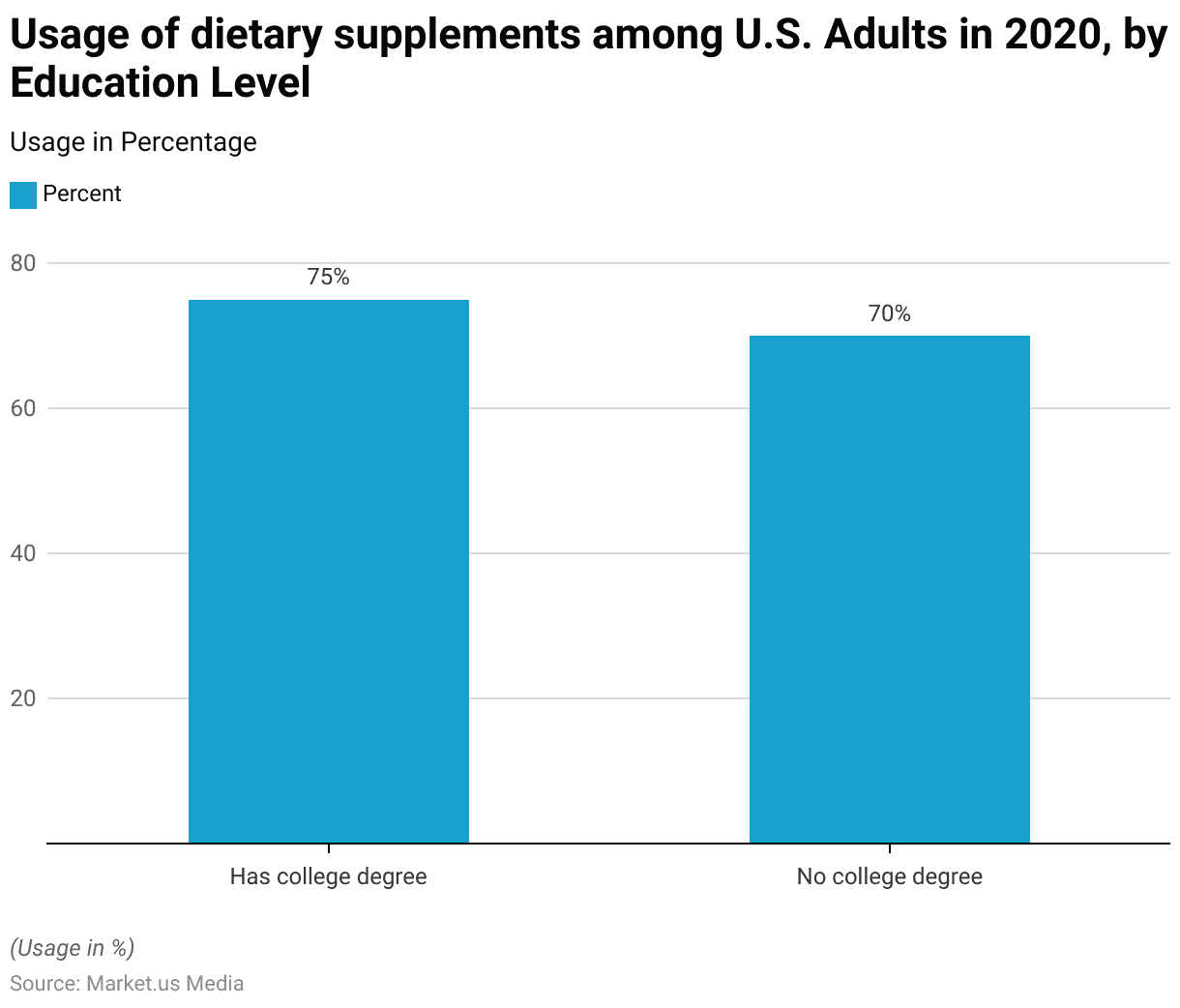
Consumer Behavior and Trends
Interest in Healthy Food Trends By Nutrition Industry Statistics
- In 2019, Canadian respondents showed a strong interest in healthy food trends and a strong inclination towards plant-based and innovative food options.
- Plant-based meat substitutes garnered the highest interest, with 75% of respondents expressing interest.
- This was closely followed by turmeric-spiced food and beverages, which attracted 72% of respondents.
- Plant-based dairy substitutes were of interest to 69%, while 68% showed a preference for cauliflower pizza crust.
- Sea-based protein and organic wine each captured the interest of 66% of respondents.
- Oat milk and fermented products were each favored by 58% of respondents.
- Non-alcoholic beer, wine, and spirits appealed to 56% of respondents, while 48% were interested in CBD-infused foods and beverages.
- The least interest was observed for insect protein and eating insects, with 38% of respondents indicating interest.
- This data reflects a diverse and growing curiosity among Canadians towards various health-conscious and alternative food trends.
(Source: Statista)

Dietary Supplement Usage – By Healthy Habits in Nutrition Industry Statistics
- In 2023, healthy habits among U.S. adults showed notable differences between users and non-users of dietary supplements.
- Among those who take supplements, 82% reported trying to eat a balanced diet, compared to 70% of non-users.
- Regular doctor visits were reported by 78% of supplement users, whereas only 63% of non-users did the same.
- Exercise was a common habit for 72% of supplement users, in contrast to 58% of non-users.
- Getting a good night’s sleep was reported by 69% of those who take supplements, compared to 63% of non-users.
- Additionally, 69% of supplement users maintained a healthy weight, while 64% of non-users reported doing so.
- This data indicates that users of dietary supplements are more likely to engage in a variety of healthy habits compared to those who do not take supplements.
(Source: Statista)
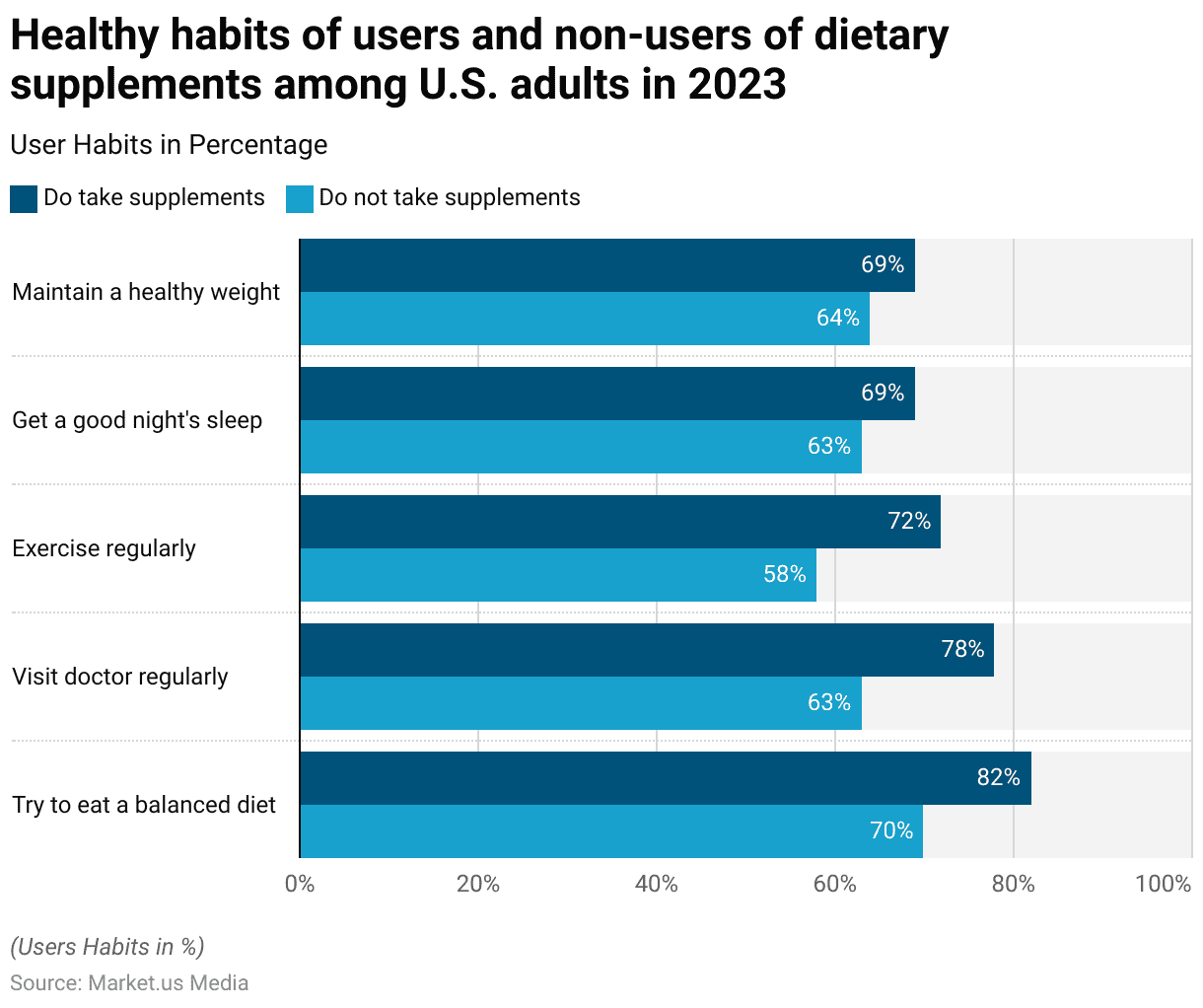
Types of Food Supplements Preferred Among Consumers
- In 2018, French consumers exhibited distinct preferences for different types of food supplement tablets.
- Hard capsules were the most preferred, with 46% of respondents favoring this form.
- Tablets followed, with 17% of respondents indicating a preference for them.
- Soft capsules were chosen by 14% of consumers. While liquid supplements were preferred by 12%.
- Powder forms of supplements were the least popular, with only 8% of respondents favoring them.
- This ranking highlights the varying preferences for supplement delivery methods among French consumers.
(Source: Statista)
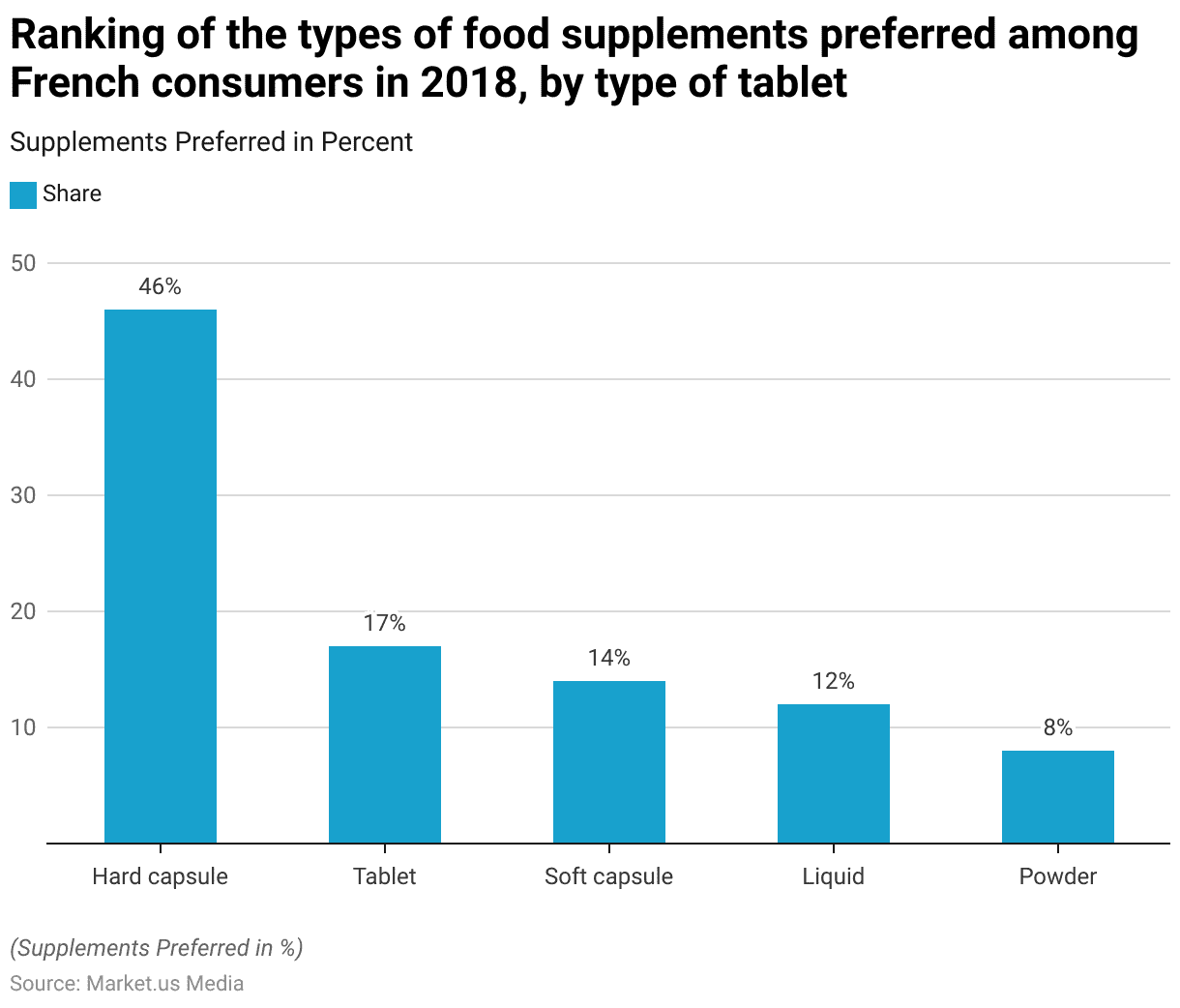
Vitamin and Mineral Supplements Preferences Among Adults
- In 2017, the most popular types of vitamin and mineral supplements among U.S. adults were led by multivitamins, with 73% of adult supplement users incorporating them into their routine.
- Vitamin D was the second most commonly used. With 37% of adults taking this supplement.
- Vitamin C followed, with a usage rate of 32%.
- Calcium supplements were used by 26% of adults, and Vitamin B or B Complex supplements were taken by 24% of the population.
- This data underscores the prevalence of these specific vitamins and minerals in the dietary habits of U.S. adults.
(Source: Statista)
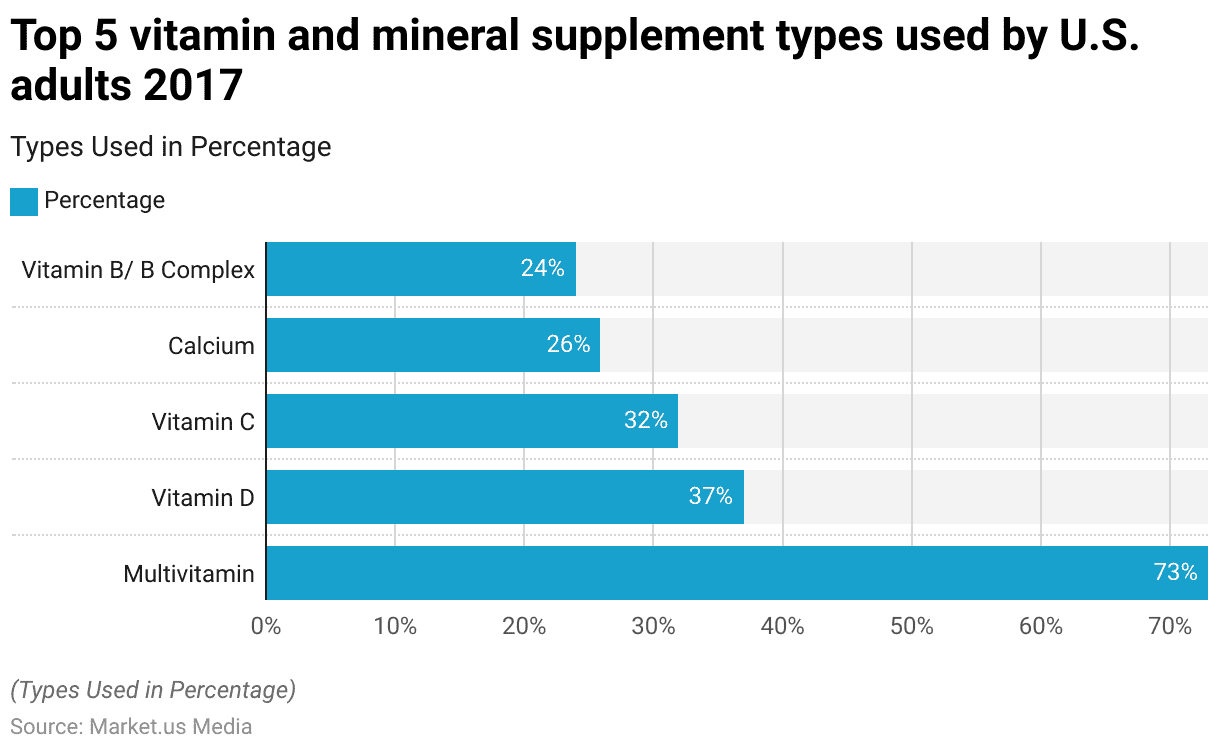
Satisfaction of Consumers Concerning the Health Benefits of Food Supplements
- In 2019, French consumers had varied opinions on the health benefits of nutritional supplements.
- A significant majority, 61%, reported being rather satisfied with the health benefits provided by these products.
- Meanwhile, 17% of respondents were totally satisfied.
- An equal percentage, 17%, were rather unsatisfied with the benefits of nutritional supplements.
- A small proportion, 3%, were
- unsatisfied, and 2% of respondents did not provide an answer.
- This data highlights a predominantly positive perception of nutritional supplements among French consumers, with a notable portion expressing high levels of satisfaction.
(Source: Statista)
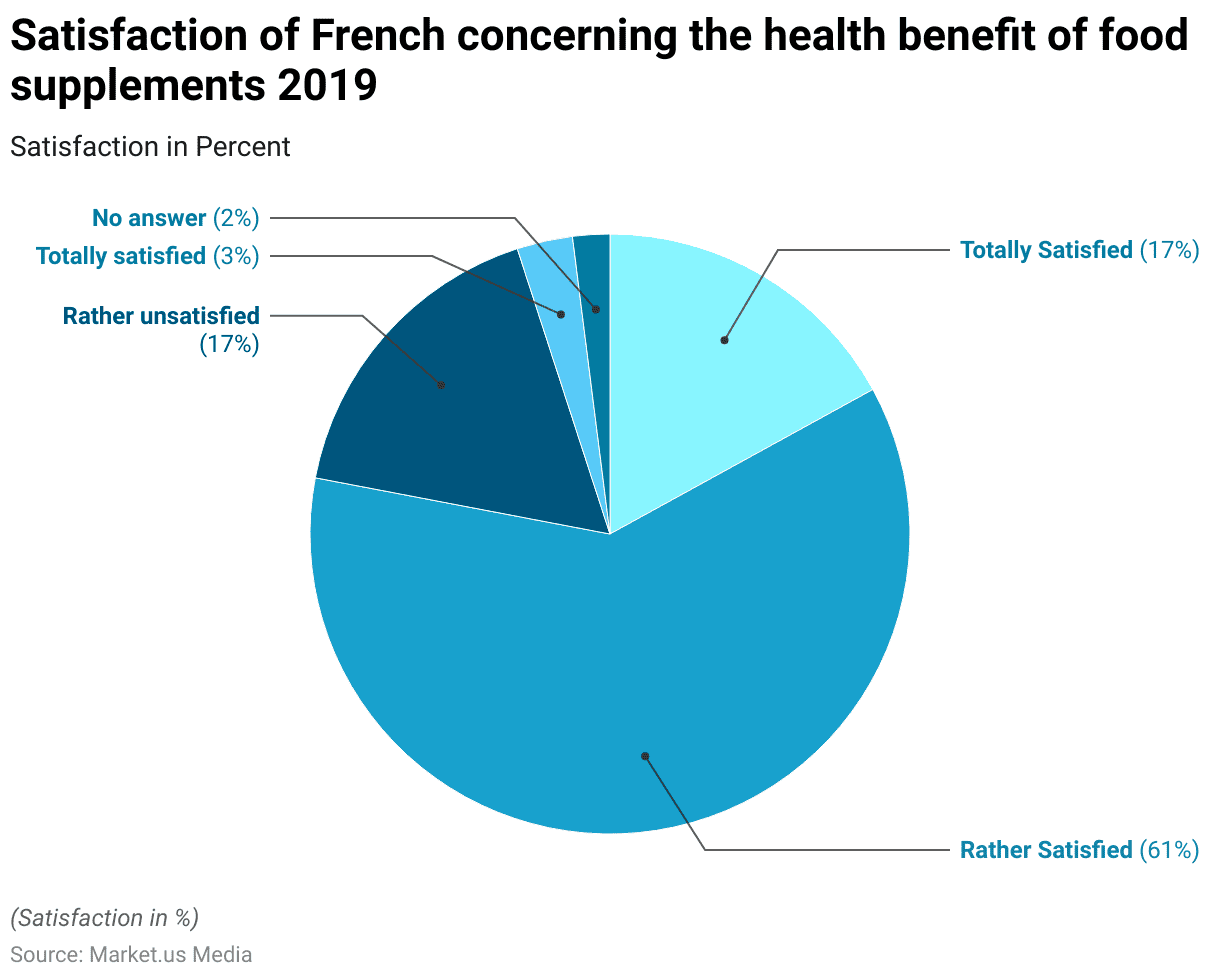
Spending Habits and Cost by Nutrition Industry Statistics
- Despite inflation and economic uncertainty, 65% of supplement users have maintained their monthly spending on supplements at the same level as the previous year; 29% have increased their spending, while 6% have decreased it.
- Men are more likely than women to report spending more. Individuals aged 18-34 are more inclined than those over 55, and regular supplement users are more prone to increased spending compared to seasonal or occasional users.
- A higher proportion of non-users now consider supplements too expensive. With 28% expressing this view this year, compared to 17% in 2021 and 19% in 2019.
(Source: Council for Responsible Nutrition’s 2023 Consumer Survey)
Recent Trends
- According to responses from this year’s survey, approximately 92% of participants believe that dietary supplements are crucial for maintaining their health, with 49% expressing this view somewhat strongly and 42% strongly agreeing.
- Among supplement users, more than half (52%) of Black individuals strongly affirmed the necessity of supplements for health maintenance, a higher proportion compared to users of other racial or ethnic groups.
- Furthermore, 89% of all users concurred that taking nutritional or dietary supplements enables them to manage their health and wellness proactively, with 62% agreeing somewhat and 27% strongly agreeing.
- Although the use of sports nutrition declined during the pandemic, falling to 30% in 2020, it has increased by nine percentage points to 45% in 2023 compared to 36% in 2019.
- Current usage of sports nutrition products is notably high among younger supplement users, individuals earning over $100,000 annually, and parents.
More Insights
- Among supplement users, confidence in the safety and quality of sports nutrition supplements has risen by five percentage points to 66% compared to the previous year. In comparison, confidence in the weight management category increased by four percentage points to 56% from 2022.
- Melatonin has become the most commonly used specialty supplement, rising to 17% in 2023 from 13% in 2022, effectively surpassing omega-3s, which have decreased to 13% from 17% last year.
- Among supplement users who rely on healthcare professionals for trustworthy information about supplements, 62% have consulted a primary care physician (PCP) regarding their use.
- Furthermore, 25% of Americans overall and 15% of those who do not currently use supplements. Indicated that they might consider taking supplements if they were covered by insurance.
- When purchasing dietary supplements, the most significant factors are product labels (62%) and price (53%), followed by a doctor’s recommendation (45%) and specific ingredients (32%).
(Source: Council for Responsible Nutrition’s 2023 Consumer Survey)
Regulations for Nutrition Industry Products Statistics
- Regulations for nutritional products vary significantly across countries, reflecting diverse public health priorities and market practices.
- In the United States, the FDA mandates comprehensive nutritional labeling on food packaging, detailing calories, fats, sugars, and other key nutrients, with recent updates focusing on front-of-package labeling to enhance consumer transparency.
- Canada has similar stringent requirements under Health Canada’s Healthy Eating Strategy, with a compliance deadline set for January 1, 2026, ensuring products feature clear nutritional symbols and detailed nutrient content claims.
- Vietnam has implemented mandatory nutritional labeling, effective February 2024, requiring detailed disclosures of energy, protein, carbohydrates, fats, and sodium on all food products.
- The Philippines recently updated its policies to align with international standards, mandating labels to display sodium and caloric content based on the Recommended Energy and Nutrient Intakes (RENI).
- These regulations collectively aim to improve consumer awareness, promote healthier dietary choices, and ensure uniformity in nutritional information across global markets.
(Sources: Nutritional Outlook, Food Compliance, Food Navigator Asia, Government of Canada, Vietolab)
Recent Developments
Acquisitions and Mergers:
- Nestlé acquires Orgain: In early 2023, Nestlé acquired Orgain, a plant-based nutrition company, for $550 million. This acquisition aims to expand Nestlé’s portfolio in the health and wellness sector by integrating Orgain’s organic and plant-based products.
- Unilever acquires Liquid I.V.: Unilever completed its $800 million acquisition of Liquid I.V., a hydration-focused nutrition brand, in mid-2023. This merger is expected to strengthen Unilever’s presence in the functional nutrition market.
New Product Launches:
- Herbalife’s Protein Bars: In early 2024, Herbalife introduced a new line of protein bars designed to provide a convenient and nutritious snack option. These bars feature high protein content, low sugar, and a variety of flavors to cater to health-conscious consumers.
- Garden of Life’s Organic Vitamin Line: Garden of Life launched an organic vitamin line in mid-2023, offering a range of vitamins and supplements made from whole food ingredients, targeting consumers seeking natural and organic health solutions.
Funding:
- Huel secures $100 million: In 2023, Huel, a company known for its nutritionally complete meals and shakes. Raised $100 million in a funding round to expand its product range, enhance distribution channels, and increase its presence in new markets.
- Athletic Greens raise $150 million: Athletic Greens, a provider of daily nutritional supplements, secured $150 million in early 2024 to invest in R&D. Improve product formulations, and accelerate global expansion efforts.
Technological Advancements:
- Personalized Nutrition: Advances in AI and machine learning are being used to develop personalized nutrition plans. Based on individual health data, genetic profiles, and dietary preferences. Offering customized dietary recommendations for better health outcomes.
- Sustainable Packaging: The development of sustainable packaging solutions, such as biodegradable and recyclable materials, is enhancing the environmental footprint of nutrition products. Meeting the growing consumer demand for eco-friendly options.
Market Dynamics:
- Growth in the Nutrition Market: The global nutrition market is projected to grow at a CAGR of 6.5% from 2023 to 2028, driven by increasing health awareness. Rising demand for functional foods and supplements, and the trend towards personalized nutrition.
- Rising Popularity of Plant-Based Nutrition: Plant-based nutrition products are gaining popularity among consumers seeking healthier and more sustainable dietary options. Contributing to market growth and innovation in plant-based product lines.
Regulatory and Strategic Developments:
- EU Nutrition and Health Claims Regulation: The European Union updated its Nutrition and Health Claims Regulation in early 2024. To ensure that health claims made by nutrition products are scientifically substantiated and communicated to consumers.
- US FDA Guidelines for Supplements: The US Food and Drug Administration (FDA) issued new guidelines in 2023. To improve the safety and labeling of dietary supplements. Focusing on transparency and accurate ingredient disclosure.
Research and Development:
- Functional Ingredients: R&D efforts are focusing on discovering and developing new functional ingredients, such as probiotics, prebiotics, and adaptogens. To enhance the health benefits of nutrition products and meet consumer demand for innovative solutions.
- Nutritional Genomics: Researchers are exploring the field of nutritional genomics to understand. How individual genetic variations affect dietary needs and responses. Paving the way for more precise and effective nutrition interventions.
Conclusion
Nutrition Industry Statistics – The nutrition industry has experienced robust growth and diversification. Driven by increasing consumer demand for health and wellness products.
Further, key segments like dietary supplements, functional foods, and clinical and sports nutrition have expanded significantly.
Moreover, regional variations reflect cultural and demographic influences on consumer behavior. Technological advancements and a focus on research have spurred innovation, leading to new product introductions.
Finally, The rising interest in plant-based, organic, and personalized nutrition highlights the industry’s adaptability to emerging trends.
Overall, the nutrition industry is a dynamic and essential part of the global health and wellness landscape, continually evolving to meet consumer needs.
FAQs
The nutrition industry encompasses a broad range of products and services designed to support health and wellness. This includes dietary supplements, functional foods, sports nutrition, and clinical nutrition products.
Dietary supplements are products intended to supplement the diet. They can include vitamins, minerals, amino acids, herbs, and other substances that provide nutritional benefits.
Functional foods are foods that have a potentially positive effect on health beyond basic nutrition. Examples include fortified foods, probiotics, and foods rich in antioxidants.
The nutrition industry has seen significant growth due to increased consumer awareness of health and wellness. Technological advancements, and a rising demand for personalized nutrition and plant-based products.
Key trends include the rise of plant-based and organic products, personalized nutrition solutions, and an increasing focus on sustainability and environmental impact.
Discuss your needs with our analyst
Please share your requirements with more details so our analyst can check if they can solve your problem(s)



